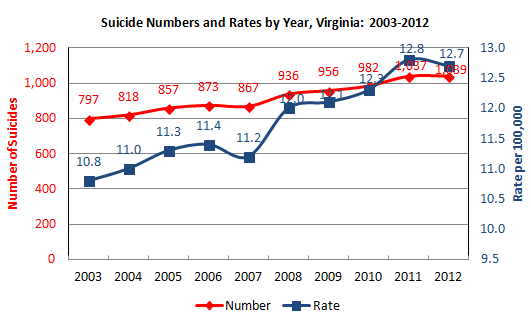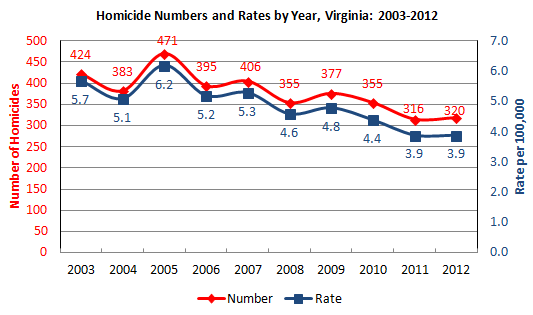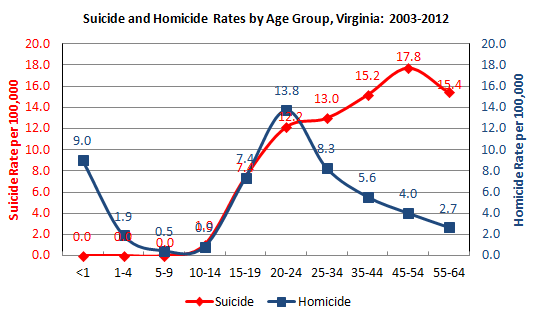Background | Key Activities, Data Findings and Accomplishments | Partners | Reports and Publications | Links | Data Requests | Contact Us
Background
Beginning in 2003, the Office of the Chief Medical Examiner implemented the National Violent Death Reporting System (NVDRS) in Virginia. The NVDRS is a public health data collection system designed to better understand the breadth and scope of fatal violence and its victims and to support data driven violence prevention efforts. The NVDRS links information in six types of violent deaths – homicides, suicides, accidental firearm deaths, legal interventions, deaths due to acts of terrorism, and undetermined deaths likely related to violence – using a variety of death investigation sources such as forensic pathology, law enforcement, forensic science, and vital records.
The Virginia Violent Death Reporting System (VVDRS) is the operation and reporting system of the NVDRS within Virginia, and uses the methodology, definitions, coding schema, and database of the NVDRS. Funded through the Centers for Disease Control and Prevention (CDC), and operating now in 32 states, the goal of the NVDRS is to establish a national violent death surveillance system. Virginia was among the first six states to implement the NVDRS, and the first statewide medical examiner system to do so.
Key Activities
- Compiling information sources from violent death investigations and correlating victims with circumstances such as mental illness, intimate partner violence, and other issues that contribute to violent death.
- Assisting government and other policy makers in their efforts to understand the extent of violence in Virginia, to develop public health interventions, and to evaluate violence prevention program efforts.
- Educating the general public about types and characteristics of violent death.
- Generating timely, useful, and detailed information about violent death events at the local and state levels.
- Helping to develop and inform injury and violence prevention efforts.
Data Findings
- In Virginia, there are an average of 916 suicides and 380 homicides per year; that means that for every homicide, there are 2.4 suicides each year. While suicides have increased over the past 10 years, homicides have decreased.


- Suicide decedents are primarily male (77%) and White (87%), with a median age of 46. The risk of suicide generally increases with age. Firearms are the most common method of fatal injury (56%). Urban and metropolitan areas are most commonly where suicides occur, but rural areas have the highest rates of suicide.
- The events and conditions that lead to suicide are complex, but common issues include mental health problems (55%), a recent life crisis (38%), conflict with intimate partners (34%), abuse of alcohol and/or other substances (28%), and physical health problems (19%).
- Homicide decedents are primarily male (76%) and Black (60%), with a median age of 29. Generally, the risk for homicide increases until the ages of 20-24, then declines again. Firearms are the most common method of fatal injury (70%). Urban areas have the highest numbers and rate of homicides.

- Homicides are most frequently related to general arguments (43%), intimate partner violence (27%), and as a by-product of other crimes (e.g., robbery, burglary) (26%).
Accomplishments
- VVDRS is documenting the public health burden of suicide, homicide, and unintentional firearm deaths in Virginia, noting populations and communities at risk, as well as critical characteristics of and precursors to fatally violent events.
- VVDRS reveals that middle aged white males are most at risk for suicides and that circumstances surrounding a completed suicide are nuanced and vary over the life course. For instance, relationship problems and substance use problems are important early in the life span, while health concerns are more common among older adults.
- VVDRS has provided a clearer public health picture of homicide in the Commonwealth, particularly as it is relates to populations such as the homeless, homicide in the workplace, and homicide among persons in legal custody. Like suicide, populations at risk and the circumstances surrounding homicide vary by age, by race, and by gender.
- By generating county and city specific violent death profiles, VVDRS data are being used at the state and local level to inform suicide prevention planning and response strategies.
- VVDRS has been recognized by the CDC as among the strongest violent death surveillance programs in the country.
Partners
The following collaborative partners support the efforts of the VVDRS through resource and information sharing:
- Division of Health Statistics, Virginia Department of Health
- Division of Prevention, Health Promotion, and Tobacco Control, Virginia Department of Health
- Division of Vital Records, Virginia Department of Health
- Prevent Child Abuse Virginia
- Virginia Association of Chiefs of Police
- Virginia Center for Public Safety
- Virginia Department for Aging and Rehabilitative Services
- Virginia Department of Behavioral Health and Developmental Services
- Virginia Department of Forensic Science
- Virginia Department of Social Services
- Virginia Sexual and Domestic Violence Action Alliance
- Virginia Sheriffs’ Association and Institute
- Virginia State Police
Reports and Publications
I. Suicide
Women and Suicide in Virginia
Published: February, 2105
Suicide and Placement for Nursing Home or Hospice Care in Virginia
Published: February, 2014
Elder Suicide in Virginia: 2003-2010
Published: March, 2013
Military-Related Suicide in Virginia: 2003-2010
Published: October, 2012
Physical Health Problems and Suicide in Virginia: 2007-2010
Published: July, 2012
Suicide Trends in Virginia: 2003-2010
Published: May, 2012
Suicide Among College Students in Virginia: 2003-2008
Published: November, 2011
Suicide and Criminal Legal Problems in Virginia: 2007-2008
Published: September, 2011
Suicide in the Eastern Health Planning Region: 2003-2008 (PowerPoint presentation)
Presented: June 15, 2011
Suicide in the Northern Health Planning Region: 2003-2008 (PowerPoint presentation)
Presented: June 6, 2011
Suicide in the Central Health Planning Region: 2003-2008 (PowerPoint presentation)
Presented: June 1, 2011
Suicide in the Northwest Health Planning Region: 2003-2008 (PowerPoint presentation)
Presented: May 24, 2011 and May 25, 2011
Suicide in the Southwest Health Planning Region: 2003-2008 (PowerPoint presentation)
Presented: May 10, 2011 and May 11, 2011
Suicide Methods in Virginia: Patterns by Race, Gender, Age, and Birthplace
Published: April, 2011
Alcohol Consumption Before Fatal Suicides
Published: August, 2010
Poison-Related Attempted and Completed Suicides in Virginia: 2003-2006
Published: September, 2009
Suicide and Mental Health in Virginia: 2003-2007 (PowerPoint presentation)
Presented: June, 2009
Final Exit: What Type of Suicide Victim Seeks Guidance?
Published: February, 2009
Suicides of Children in Virginia
Published: May, 2008
II. Violent Death
Violent Death Among Hispanics in Virginia 2003-2014
Published: September, 2017
Violent Death Among Asians in Virginia, 2003-2014
Published: May, 2017
Homelessness and Violent Death
Published: October, 2013
Violent Death in Custody: 2003-2010
Published: February, 2013
Violent Death in the Workplace
Published: November, 2012
The Geography of Violent Death in Virginia: 2003-2008
Published: November, 2011
Deaths from Violence: A Look at 17 States
Published: December, 2008
Violent Death in Virginia: 2006
Published: April, 2008
III. Homicide
Homicide Across the Life Course
Published: October, 2013
Substance Use and Violence
Published: December, 2008
IV. Unintentional Firearm Death
Unintentional Firearm Deaths in Virginia, 2003-2006
Published: December, 2007
Links
- National Violent Death Reporting System
- National Violence Prevention Network
- Prevention Institute
- Suicide Prevention Resource Center
- Virginia Department of Health, Division of Prevention, Health Promotion, and Tobacco Control
- Virginia Wounded Warrior Program
Data Requests
Contact Us
For more information, data requests, questions, and comments, contact:
Ryan Diduk-Smith
